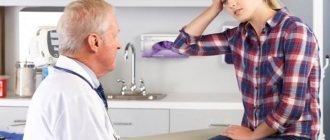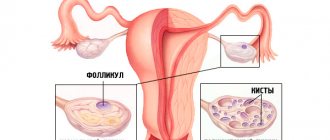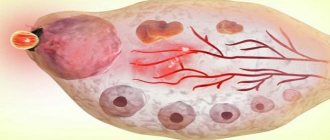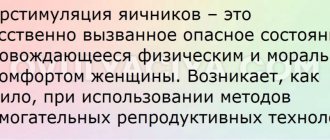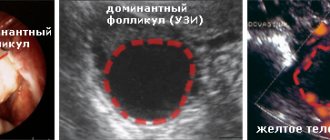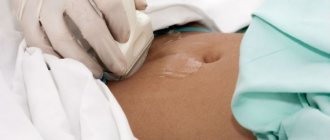A woman’s desire to become a mother is quite natural and natural. But, unfortunately, for some women the path to motherhood is long and thorny. Modern medicine offers many ways to treat infertility. One of them is stimulation of superovulation. This procedure can be an independent method of therapy or be a preparatory stage of in vitro fertilization.
According to official statistics, 35% of women who were diagnosed with infertility were able to give birth to a child after stimulating superovulation.
What it is?
A woman's menstrual cycle is divided into two phases. The first is follicular, during which follicle maturation occurs under the influence of follicle-stimulating hormone of the pituitary gland (FSH). The follicle grows, increases in volume, produces estrogens. The first phase lasts approximately 14 days.
When the size of the follicle and the concentration of estrogen reaches a maximum, the pituitary gland reacts to this and begins to produce another hormone - luteinizing hormone (LH). This is the beginning of the second phase of the cycle. Under the influence of LH, the follicle membrane ruptures and the egg “leaves” the ovary. In place of the burst follicle, a temporary structure remains - the corpus luteum. It produces progesterone, which is later needed for the development of pregnancy.
After release, the egg (oocyte) moves through the tube towards the uterus. If sexual intercourse occurs at this moment, the egg meets the sperm and conception occurs. Then the embryo descends into the uterus and implantation occurs. The corpus luteum continues to function and supports the pregnancy.
When conception does not occur, the egg enters the uterus and is removed from the body through menstrual flow. At the same time, the next follicle begins to mature. This is how the next cycle begins.
Ovulation disorders can occur at the level of the pituitary gland - it does not secrete FSH, LH or their concentration is reduced, as well as at the level of the ovaries. To eliminate the disorder, it is necessary to find out the cause and level of development of the pathology. Without this step, anything, even the most innovative, will be ineffective.
Stimulating ovulation helps the egg form and release from the follicle. In this case, the woman’s reproductive cell will be of high quality, without deviations, and capable of fertilization.
Methodology of the procedure
How to stimulate the ovaries to plan pregnancy? First, the woman needs to undergo examinations. The most important of all diagnostic procedures is ultrasound. During the procedure, the specialist examines the ovaries, determines their size and the presence of dominant follicles. The condition of the endometrium is also determined.
Ovarian stimulation involves the use of hormonal agents. Depending on the woman’s condition and her preferences, medications may come in the form of oral capsules and solutions. The latter are administered intramuscularly, intravenously or subcutaneously. Stimulation is usually carried out from the second or fifth day of the cycle. This month, a woman is prescribed at least three ultrasound diagnostics, which will help determine the moment of egg release with an accuracy of several hours.
When is ovulation stimulation necessary?
Stimulation of ovulation for conception is carried out when a woman does not become pregnant due to the absence (anovulatory cycles) or disruption of the release of the egg from the follicle. In this case, natural fertilization is planned, that is, through normal sexual intercourse.
The cause of ovulation disorders may be:
- hormonal disorders due to pathology in the ovaries or pituitary gland;
- PCOS - polycystic ovary syndrome, when the ovary is in a dense membrane, the egg cannot penetrate through it to the outside;
- accompanying illnesses;
- stress;
- taking medications;
- bad habits.
Anovulatory cycles also occur in healthy women. At a young age, there are few such cycles. The older the woman, the more often they occur, and the worse the situation with fertility - the ability to fertilize.
The ovulation stimulation procedure can be performed when a woman has a supply of eggs, that is, she has sufficient ovarian reserve. If the reserve is low, there is no point in activating the ovaries.
The procedure should be carried out in parallel with the main treatment or after it. Therefore, the first step is a thorough examination that will determine the endocrine status, the condition of the reproductive organs and the general condition of the body.
The partner is also diagnosed by a urologist-andrologist.
The main stages of ovulation stimulation
Stimulation of ovulation for conception takes place in several stages: preparation, treatment of detected disorders, stimulation. Next, we will analyze each stage in detail.
Preparation
Both the woman and the man are examined.
Diagnosis of a woman includes:
- determination of sex hormones - FSH, LH, prolactin, estradiol, testosterone;
- determination of thyroid hormones - thyroid-stimulating hormone, thyroxine, triiodothyronine;
- examination for sexually transmitted infections;
- examination of smears from the vagina, cervical canal and urethra for atypical cells and degree of purity;
- general blood and urine tests, coagulogram,
- tests for viral hepatitis, HIV;
- determination of anti-Mullerian hormone - its value can be used to estimate the reserve of eggs in the body;
- ECG with interpretation;
- Ultrasound - the condition of the reproductive organs, including the ovaries with follicle counting;
- hysteroscopy - if intrauterine pathology is suspected;
- hysterosalpingography (HSG) - assessment of tubal patency;
- laparoscopy is an invasive procedure that involves making punctures on the abdominal wall and inserting a laparoscope, a flexible tube with a camera, into the pelvic cavity.
A woman is being consulted by a therapist. This is necessary to exclude common diseases, when taking hormones to stimulate ovulation for natural conception and pregnancy are contraindicated.
The man is diagnosed by a urologist-andrologist. The list includes:
- spermogram
- tests for sexually transmitted infections;
- Ultrasound of the testicles and prostate;
- general blood and urine tests.
Treatment of detected pathologies
At this stage of stimulation of ovulation for conception, the correction of disorders that are detected during the examination is carried out. Treatment is necessary for both partners. After this, a repeat diagnosis is prescribed.
Additionally recommended:
- diet - the diet should consist of vegetables, fruits, lean meats, fish, and cereals. And you need to give up canned foods and semi-finished products. Vegetable oils and butter should be consumed, but in moderation;
- rejection of bad habits;
- refusal of intense physical activity;
- vitamin and mineral complexes as needed;
- folic acid - you need to start taking it 3 months before pregnancy.
When all the appointments are completed, the tests are normal, we begin to stimulate ovulation for conception.
Preparing for ovarian activation
Before prescribing ovulation stimulation to a patient, the attending physician must be sure that the woman’s body is completely healthy. For this purpose, special training and examination are carried out. The first thing the patient needs is a therapist’s opinion. After this, the woman turns to a gynecologist for further research:
- STI tests;
- Ultrasound of the pelvic organs;
- ultrasound examination of the breast;
- assessment of fallopian tube patency.
The last point allows for several research options:
- laparoscopy;
- metrosalpingography;
- transvaginal hydrolaparoscopy.
After passing all the necessary examinations, the woman receives a conclusion on competent and optimal treatment. Based on all indicators, a specific type of ovarian stimulation is prescribed. The doctor decides how long the course of therapy will last after examining the patient.
How to stimulate ovulation
Stimulation of ovulation is the administration of drugs that cause the maturation of the egg. At the same time, it is necessary to prepare the endometrium of the uterus so that by the time of conception it is of the required thickness, and implantation is successful. All procedures are carried out under strict medical supervision and ultrasound monitoring. The doctor monitors the body's reaction to the drugs and monitors the growth of follicles. This way he will be able to adjust treatment in time and prevent complications.
Various methods, drugs and regimens are used. The choice depends on the result of assessing the ovarian reserve and the woman’s body weight. The result of previous procedures also matters.
Drug stimulation
How is ovulation stimulated for conception? The procedure is performed on an outpatient basis; hospitalization is not required. But she needs to be observed by a doctor and undergo all prescribed diagnostic procedures to monitor the effectiveness of therapy.
The following groups of drugs are used:
- Antiestrogens - as a result of their action on the hypothalamus and ovaries, they increase the production of sex hormones - FSH, LH. After this, the follicle matures and the endometrium thickens. The drug can cause ovarian depletion, so its use is limited. If the correction is ineffective, a repeat examination is required. According to the instructions, it is safe to use the product no more than 5 - 6 times;
- Human menopausal gonadotropin - has follicle-stimulating and gonadotropic effects, which leads to an increase in the concentration of sex hormones. Stimulates follicle growth, maturation and ovulation;
- Recombinant FSH drugs are obtained through genetic engineering. Stimulating ovulation with these drugs leads to the same results as with the use of anti-estrogens and gonadotropins.
As treatment progresses, the woman undergoes ultrasound diagnostics and the size of the follicles is determined daily. Rupture of the follicle membrane occurs when the follicle size is 17 - 18 mm. Stimulation of ovulation is carried out precisely at this moment by injecting hCG - human chorionic gonadotropin. This hormone is normally secreted by the chorion after embryo implantation, but when applied in the middle of the cycle, it helps the oocyte “get out” of the follicle. The dosage is selected individually.
After the injection, 24 to 36 hours later, the membrane ruptures and the egg enters the abdominal cavity. The drug also prepares the uterus for implantation of the embryo and the formation of the placenta.
After stimulating ovulation, ultrasound control is performed to conceive naturally. If ovulation occurs, a corpus luteum forms at the site of the follicle. It releases progesterone, which is necessary to support pregnancy. But since a woman has hormonal disorders, the doctor prescribes additional help for the corpus luteum: progesterone tablets. They promote implantation and then the normal development of pregnancy, eliminating the threat of miscarriage.
The most favorable period for conception is from the day of hCG injection until the formation of the corpus luteum. If the results of spermogram and other tests are good, then it is recommended to have sexual intercourse during this period. If it is impossible to conceive naturally, artificial insemination is performed - the husband's sperm is injected through a catheter into the uterus.
Stimulating ovulation with folk remedies
Stimulating ovulation for conception using folk remedies involves the use of herbal decoctions internally and externally, mud therapy, and a diet to normalize hormonal levels.
The herbs used are sage, linden blossom, hogweed, red brush, rosemary, and plantain. These plants contain phytoestrogens - analogues of the natural hormones of the female body. They cause the egg to mature. They are used internally in the form of decoctions, and also make baths. Despite the fact that these are natural remedies, they can only be taken after consultation with a doctor and in the dosage prescribed by him. If the dose is exceeded, herbal remedies can cause ovarian depletion.
Stimulating ovulation for conception using folk remedies using medicinal mud leads to normalization of hormonal levels. It also eliminates the inflammatory process of the pelvic organs. The correction is also effective for polycystic ovary syndrome. Wraps and applications are possible. Therapy is prescribed by a doctor. A course of treatment consisting of several sessions is recommended.
Special food
Certain foods not only improve the health of expectant parents, but also normalize hormonal levels and accelerate egg maturation and ovulation. These properties are found in egg yolks, milk, fruits and vegetables (apples, sprouted wheat, legumes, sesame seeds, soybeans, dates, beets, carrots, tomatoes, cucumbers, pomegranates, pineapples, spinach).
Psychological help
Separately, it is worth mentioning psychological preparation. The psychological state plays an important role in the functioning of the reproductive organs. Stress - and it is inevitable when planning a pregnancy during anovulatory cycles, when the result cannot be guaranteed with 100% certainty - worsens the condition of the reproductive organs and the endocrine system.
Therefore, a woman during the period of stimulation of ovulation in order to conceive naturally needs to pay attention to this area. Psychotherapy sessions and sedatives are recommended.
One of the ways to achieve emotional balance is to abstract from the problem. It’s worth trying to distract yourself, live a normal life, without focusing on ovulation and other aspects. Perhaps you can look for some methods of relaxation: yoga, meditation, art therapy. Of course, adequate sleep and rest are essential.
Ultrasound monitoring
To detect and establish the causes of problems with ovulation, repeated ultrasound procedures, namely folliculometry, are necessary.
If there is a stable 28-day cycle, the first ultrasound can be done on the 8-10th day from the last day of menstruation and then ultrasound is performed every 2-3 days (the presence, number and growth of follicles in the ovary are monitored) until the day the fact of ovulation is established or the beginning of a new menstruation.
As a result of an ultrasound examination, the doctor can obtain the following information:
- follicles do not develop and, as a result, there is no ovulation
- the follicle develops, but regresses (stops in development and disappears, never reaching the required size), ovulation is absent
- the dominant follicle develops, but does not grow to the required size, ovulation is absent
- the dominant follicle develops, grows to the required size, but does not rupture (a functional ovarian cyst is formed, which goes away with menstruation), ovulation is absent
- the follicle develops, ovulation occurs and a corpus luteum appears in place of the follicle
When obtaining the last result, stimulation is not required - your body copes with this function perfectly.
Contraindications
Hormonal stimulation of ovulation for conception is contraindicated in:
- amenorrhea - the menstrual cycle should first be restored;
- excess weight or anorexia - both conditions negatively affect the functioning of the reproductive organs;
- high testosterone - at the second stage, hormonal imbalance should be corrected so that after conception there is no threat of miscarriage and other problems;
- somatic pathology of the kidneys, liver, heart and blood vessels, nervous system;
- neoplasms - not only in the pelvis, but throughout the entire body;
- any deviations in analyzes and examination results without correction.
Advice for future parents
Stimulating ovulation for conception is one of the most gentle ways to prepare for pregnancy. Its advantage is that fertilization occurs naturally after the couple’s intimacy. The main condition for a successful result is a thorough examination of the spouses and finding out the cause of infertility. In this way, doctors correct the disorders, and only after all indicators are normalized do they begin to stimulate ovulation.
Pregnancy does not always occur the first time. Sometimes you have to wait and try several cycles before you see the coveted two lines on the test. Be patient, trust your doctor, follow all his recommendations, including lifestyle and nutrition - then luck will definitely smile on you!
Possible side effects
Gynecologists and reproductive specialists at Life Line stimulate the ovaries of patients with gentle and effective medications. For most expectant mothers, stimulation does not cause any noticeable discomfort. However, due to the influence of hormonal drugs during the procedure, side effects are possible:
- reduced emotional background;
- pain in the lower back and ovarian area;
- headache;
- sleep problems;
- bloating;
- sweating, hot flashes.
The most dangerous possible complication is considered to be ovarian hyperstimulation syndrome (OHSS). It is observed extremely rarely. In addition, a good doctor will not miss the signs of OHSS and will take the necessary measures in time.
